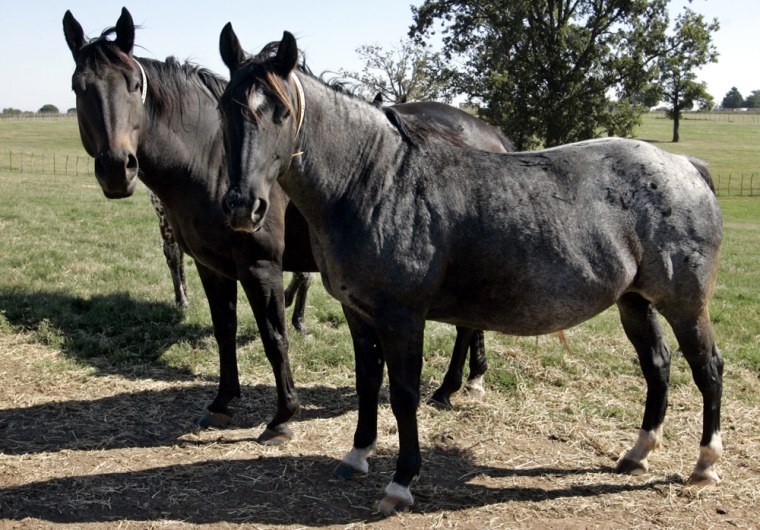The more than 30 healthy-looking horses in a pasture here are all shapes and sizes and include an Appaloosa, a couple of bays, chestnuts, a paint and a Palomino.
One thing that these mares have in common is that they are pregnant — and not naturally.
Each has been impregnated with a cloned embryo produced by ViaGen Inc., an Austin, Texas, company that specializes in cloning horses, cattle and pigs. The mares are due to deliver in February.
Iran Polejaeva, chief scientific officer with ViaGen, said the company has successfully produced clones in seven different animal species. It is focusing on cloning performance horses for customers who want to continue their horses’ genetic makeup.
Currently, the firm is not cloning thoroughbred racing horses. The Jockey Club, which regulates the registration of thoroughbreds, will not allow any foal to be registered that is produced by artificial insemination, embryo transfer or transplant, cloning or any other form of genetic manipulation.
The health of the breed is better served with natural breeding, said Bob Curran Jr., vice president of corporate communication for the Jockey Club.
“Because the technology is so new, the health ramifications of cloned foals need to be studied,” Curran said. The Jockey Club uses parentage verification along with DNA testing to make sure the foal has been naturally bred.
Michael San Filippo, spokesman for the American Veterinary Medical Association, said endurance horse racing allows cloned competitors, as do the equine sports of show jumping, polo, carriage horse racing and dressage, horsemanship’s equivalent of gymnastics or ballet dancing.
“In dressage, most of the animals are geldings and they can’t reproduce, so when you have an outstanding horse, then you can use the cloning process to preserve the genetic lines,” Polejaeva said.
ViaGen contracts with Purcell-based Royal Vista Southwest, which provides horses to carry the cloned embryos. They are produced in a process where the DNA-bearing nucleus of a horse’s cell is placed into an unfertilized egg, which has had its nucleus removed.
The implanted DNA drives the egg to develop into an embryo, which is placed in a mare, which carries it to term and gives birth to a genetic clone of the animal whose DNA began the process.
The first cloned horse was born in 2003 in Italy. In 2005 Texas A&M University created the first cloned horse in the United States.
“Cloning is just another reproductive technology,” said Polejaeva, similar to embryo transfer or artificial insemination. The cost is about $150,000.
Jim Bailey a veterinarian and an owner of Royal Vista Southwest, said technicians screen the mares for reproductive soundness, make sure they are healthy and gentle, and see that the social order in the herd has been established.
“The secret to good stock is to keep them stress-free,” Bailey said. “Most of these mares would go to slaughter if they were not being used for embryo transfers.”
He said the mares are kept outside, even during the winter, and only taken into a barn at night when it comes closer for them to deliver a colt.
“We keep a really close watch on them when it gets close to their delivery day because we only have a small window of opportunity of about 25 minutes to an hour to help with the delivery in case there is a problem,” Bailey said.
Bailey is excited about the biological technology that allows for reproductive technology such as cloning and embryo transfer.
“In the past two years we have been making progress by leaps and bounds, so who knows where this technology will advance in the next two,” Bailey said.
